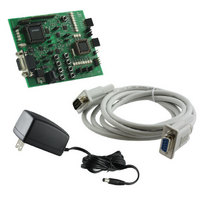OM6277,598 NXP Semiconductors, OM6277,598 Datasheet - Page 9

OM6277,598
Manufacturer Part Number
OM6277,598
Description
DEMO BOARD FOR PCA9564
Manufacturer
NXP Semiconductors
Datasheet
1.OM6277598.pdf
(52 pages)
Specifications of OM6277,598
Main Purpose
Interface, I2C Controller
Embedded
Yes, MCU, 8-Bit
Utilized Ic / Part
PCA9564
Primary Attributes
I2C Bus Controller, 1 8-Bit GPIO, 1 8-Bit LED Dimmer
Secondary Attributes
8 Momentary Switches, 23 LEDs
Lead Free Status / RoHS Status
Not applicable / Not applicable
Other names
568-4001
935283226598
935283226598
ISP programming for both devices can be done using Flash Magic. Flash Magic is a free, powerful, feature-rich
Windows application that allows easy programming of Philips Flash microcontrollers. Flash Magic uses Intel Hex files
as input to program the targeted device. For download information, refer to the paragraph “Download software,
programs and documentation”.
P89LV51RD2 ISP programming
a) Set jumpers JP2 and JP3 to target P89LV51RD2 device: both jumpers connected between 2 and 3
b) Connect the DB-9 cable between the PC serial port and the PCA9564 evaluation board DB-9 connector
c) Enter the P89LV51RD2 ISP mode as requested in the Flash Magic pop up window: This is done by pushing the
d) Open Flash Magic and go through the five following steps:
e) Exit the P89LV51RD2 ISP mode when programming done (“Finished” displayed at the bottom of the Flash Magic
f)
P89LPC932 ISP programming
a) Set jumpers JP2 and JP3 to target P89LPC932 device: both jumpers connected between 1 and 2
b) Connect the DB-9 cable between the PC serial port and the PCA9564 evaluation board DB-9 connector
c) Enter the P89LPC932 ISP mode: This is done by setting the following jumpers:
d) Open Flash Magic and go through the 6 following steps:
e) Exit the P89LV51RD2 ISP mode when programming done (“Finished” displayed at the bottom of the Flash Magic
f)
Other features
Write Protect PCF85116
JP1 allows data protection in the PCF85116 EEPROM:
RESET pushbutton (S9) one time.
Step 1: Set the connection status and the type of microcontroller to be programmed: COM port, Baud Rate (9600),
Step 2: Flash erasing (part or all)
Step 3: Select the Hex file to be loaded in the microcontroller
Step 4: Options to be set (Memory verification, Security bits…)
Step 5: Perform the operations described in the steps above (click on “START” button)
Programming of the blocks is displayed at the bottom of the Flash Magic window.
window): This is done by pushing the RESET pushbutton one time again (S9)
Once device programming has successfully been executed, the microcontroller can run the new program.
-
-
-
-
Step 1: Set the connection status and the type of microcontroller to be programmed: COM port, Baud Rate (9600),
Step 2: Go to: Options → Advanced Options → Hardware Config
Step 3: Flash erasing (part or all)
Step 4: Select the Hex file to be loaded in the microcontroller
Step 5: Options to be set (Memory verification, Security bits…)
Step 6: Perform the operations described in the steps above (click on “START” button).
Programming of the blocks is displayed at the bottom of the Flash Magic window.
window): This is done by setting:
-
-
-
Once device programming has successfully completed, exit from the ISP. The microcontroller is now ready to run
the new program.
-
-
JP10 (RSTISP) closed
JP15 (VDDISP) open
JP6 and JP7 (I2CConnect) open
JP12 (SCLLV) and JP13 (SDALV) open
JP10 (RSTISP) open
JP15 (VDDISP) closed
State of JP6, JP7, JP12 and JP13 are function of the program requirements
JP1 open:
JP1 closed: writing to the EEPROM is allowed – memory is not protected
Check the box “Use DTR and RTX to enter ISP mode”
Device = 89LPC932
Device = 89LV51RD2
data in the EEPROM is write protected
9















